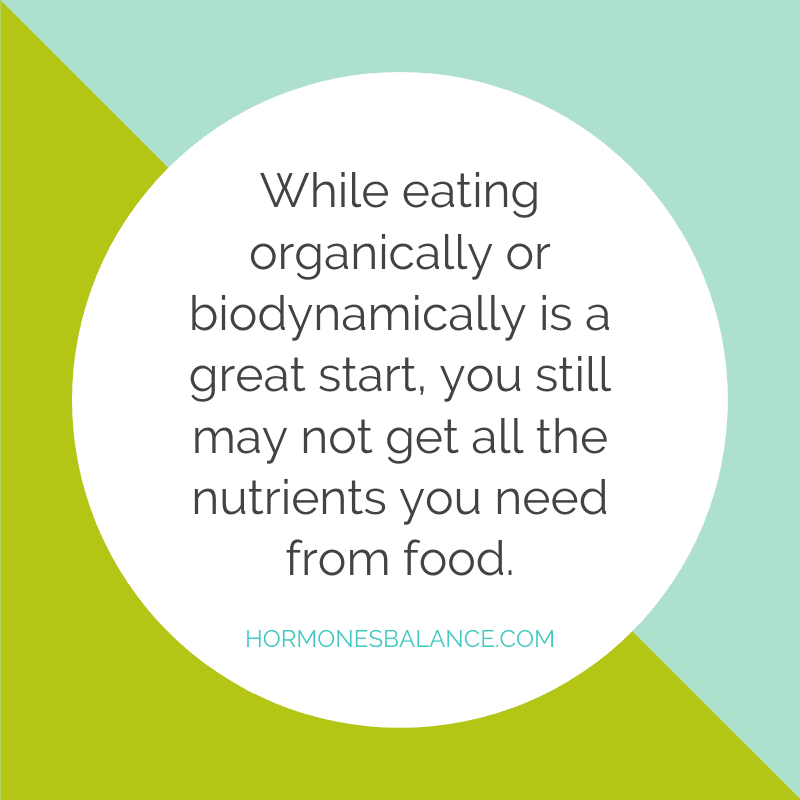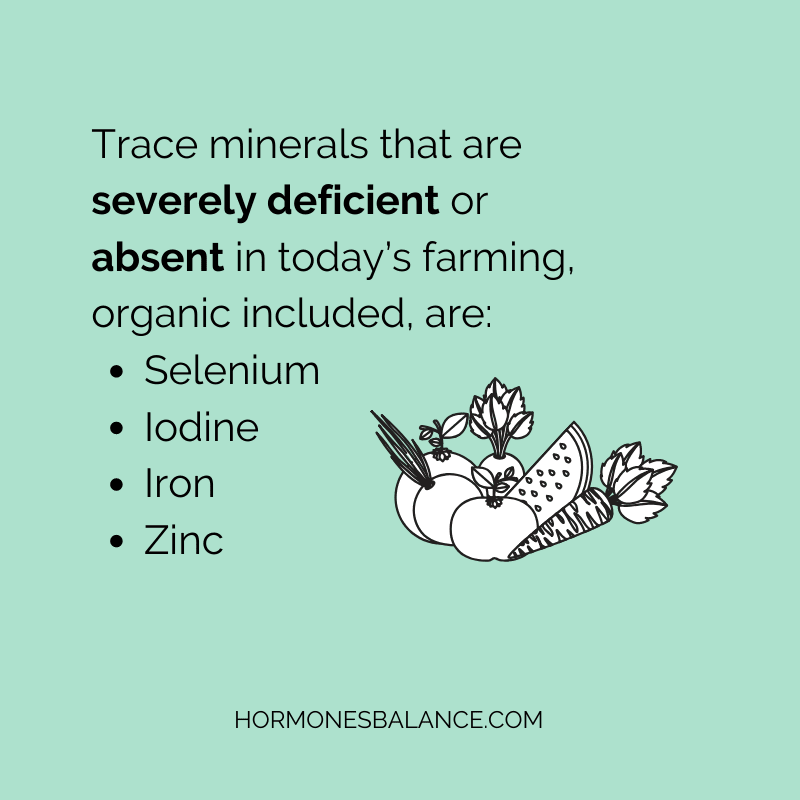
In this article, we’ll cover the vital roles of minerals in our health, and why even organic food alone isn’t an adequate source.
You will learn:
- How Organic Food Leaves Us Depleted of Minerals
- Why Minerals like Magnesium, Calcium, and Zinc are Vital to Your Health
- The Farming Practices that have Left our Produce Less Nutritious
- The Modern Fertilizer Dilemma: NPK (Nitrogen, Phosphorus, and Potassium)
- How to Know if You’re Mineral Deficient
- How to Replenish Your Micronutrient and Minerals Supply
Many years ago I was invited to a health talk about the loss of nutrients in our soil. The presentation turned out to be a multi-level marketing (MLM) supplement sales pitch, so I felt skeptical about the validity of the content. I was adamant back then that food alone can correct all nutritional deficiencies.
Over the years, as I developed vertical ridges on my nails and mouth sores, I’ve come to a solemn conclusion that food alone isn’t enough to keep me nourished and well.
In this article, I want to offer you a detailed and science-based explanation of why today’s food (even organic food) may not be enough, and what you can do to correct mineral deficiencies.
Food: Not as Nutritious as It Used to Be
If you’re working on getting your health in order, you’re probably encountering all kinds of new questions:
- Is it important to buy organic?
- Does everything have to be organic, or only things on the so-called “Dirty Dozen” list?
- Is it enough to just eat healthy, or should you also take supplements?
All of these dilemmas really come down to one question: Do our modern farming practices result in health-promoting food that meets our nutritional needs to keep us nourished and healthy?
Magazines, health food stores, and supplement companies put out information claiming that food isn’t as nutritious as it used to be—but is that really true?
It turns out, yes.
In fact, this is not a new question. Even a 1936 USA Congressional Record stated:
“Laboratory tests prove that the fruits, the vegetables, the grains, the eggs, and even the milk and the meats of today are not what they were a few generations ago (which doubtless explains how our forefathers thrived on a selection of foods that would starve us today).
It is bad news to learn from our leading authorities that 99% of the American people are deficient in these minerals, and that a marked deficiency in any one of the more important minerals actually results in disease.
Any upset of the balance, any considerable lack of one or another element, however microscopic the body requirement may be, and we sicken, suffer, and shorten our lives.” – Senate Document No. 264, 1936. 74th Congress, 2nd Session.
A 2006 study of 20 individuals (14 athletes, 6 sedentary) published in the Journal of the International Society of Sports Nutrition analyzed the micronutrients of their diets which were intended to improve their micronutrient intake. The seven minerals included were iodine, potassium, calcium, magnesium, phosphorus, zinc, and selenium.
The result? Men averaged deficiencies in 54.2% of the minerals RDA and women averaged a deficiency in 44.2% of the minerals. The most common mineral deficiencies were iodine, zinc, and calcium.
A few additional highlights from the scientific literature:
- It’s estimated that up to 75% of the United States population may be deficient in magnesium.
- A 2010 study found that nearly 68% of the United States population is deficient in calcium.
- The World Health Organization (WHO) estimates about 25% of the world’s population is deficient in iron.
- According to research published by WHO, approximately 31% of the world’s population is deficient in zinc.
- A Swiss study published in 2012 estimates that about 33% of the world’s population is deficient in iodine.
Eating healthy is no longer enough to give our bodies what they need to maintain optimal health. We’re lacking in vital nutrients – especially key minerals.
Minerals for Health
Minerals are vitally important for good overall health and balanced hormones. They support three primary components of the human body:
- Bones (calcium, magnesium, and phosphorus, for example) and connective tissues (magnesium to relax muscles)
- The nervous system (potassium, for example, supports the transmitting of electrical impulses)
- Metabolism and repair (act as or support enzymes). Magnesium is needed for over 100 enzymatic reactions and Zinc is needed for over 200.
The major minerals for the human body (required in amounts of at least 100 mg per day) include calcium, chlorine, magnesium, phosphorus, potassium, sodium, and sulfur.
The trace minerals (required in amounts of 1/100 the amount of the major minerals) include aluminum, arsenic, barium, boron, bromine, cadmium, chromium, cobalt, copper, fluorine, gallium, germanium, iodine, iron, lead, lithium, manganese, molybdenum, nickel, selenium, silicon, tin, vanadium, and zinc.
Of course, some of these are toxic in higher doses, which is why we talk of poisoning occurring from aluminum, arsenic, lead, mercury, or cadmium. Poisoning can come from other minerals as well if they are taken in excess of the tolerable upper intake.
Certain minerals are especially important for hormone balance. Check out these articles on the site:
- Boost Magnesium Levels to Rebalance Your Hormones
- Using the Mighty Zinc to Balance Your Hormones
- Role of Calcium D-Glucarate in Hormone Balance
Ultimately, getting our minerals up to ideal levels is going to go a long way toward regaining or maintaining balanced hormones.
Food may be depleted in minerals compared to the farming of the past, but it’s still important. In my cookbook, Cooking For Hormone Balance, you’ll find over 125 easy, delicious recipes to nourish your body and balance your hormones without calorie restriction or deprivation. All of the recipes are based on 20 hormone-supporting superfoods and 20 hormone-supporting super herbs—with modifications for Paleo, Paleo for Autoimmunity (AIP), anti-Candida, and low-FODMAP diets. You can get a copy of the cookbook here.
How We Used to Farm Versus Today
In the past, farmers were much more likely to see themselves as the earth’s stewards, preserving the mineral-rich soil for seasons and generations to come.
To accomplish this, they would return mineral-rich wastes from both plants (compost) and animals (manure, bone meal, fish emulsion) to the soil to feed the microorganisms that thrived there. The plants would then assimilate those minerals and other nutrients and make them bioavailable to humans and animals that consumed them.
This still happens today, but to a lesser extent when the soil is lacking minerals. This is in part due to our negligence in purposely adding mineral-rich substances back into the soil.
Besides adding plant and animal wastes back to the farmland, crop rotation was once a common practice.
This method involves allowing a portion of the farmland to rest each year, with manure from grazing animals added to the soil during that year to help replenish the minerals.
Then it would be enriched yet again, ready for its turn as active farmland. A different portion was allowed to rest each year in a rotating manner.
As a part of the crop rotation, some farmers also chose to plant the land left fallow with particular crops that could restore it. Alfalfa is a crop commonly used for this purpose, as it has very deep roots (20+ feet) that can reach down to where the soil is still replete with minerals.
As the alfalfa is plowed under, those minerals are brought from the alfalfa roots to the topsoil, restoring the mineral levels for the next crop. This practice only works until the minerals from that layer of soil are depleted. Then other methods are required.
Without those traditional farming practices, the farmland gets demineralized over time, leading to lower quality produce from that land. The following charts give you an idea of how the mineral content of our foods has declined or changed over time:
Eighty-Year Decline in Mineral Content of Apples (source)
Thirty-Year Changes in Mineral Content of Broccoli – per 100 grams (source)
Thirty-Year Changes in Mineral Content of Romaine Lettuce – per 100 grams (source)
So, why the change? What did we add to the soil? Again, in the past, farmers added things like manure, compost, bone meal, fish emulsion, and pulverized minerals to re-enrich their farmland.
What do we use now? Commercial farming tends to rely on something called NPK.
The Modern Fertilizer Dilemma: NPK (Even in Organic Farming)
While traditional farming methods have relied on plant and animal waste to replenish the soil, NPK is the standard fertilizer used in modern farming, including organic.
The letters N-P-K stand for Nitrogen, Phosphorus, and Potassium (K is the chemical symbol) that make up the bulk of this blend. Sometimes, you’ll find NPKS, which includes sulfur.
Beyond air and water, plants do require N, P, and K as their primary nutrients. And while it’s certainly beneficial to add back these nutrients, the problem is that all other nutrients are omitted. That means our soil is still lacking in secondary nutrients such as magnesium, calcium, and sulfur, plus the trace elements: iron, zinc, manganese, boron, copper, molybdenum, and chlorine.
Not only is NPK-fertilized farmland lacking in important minerals, but it also results in plants and produce that are lower in vitamin C and iron. The potassium chloride that is part of the NPK leads to soil that is depleted of its magnesium, zinc, and calcium. It also causes selenium to be bio-unavailable to the plants that grow there. As a result, produce from that farmland is lower in magnesium, calcium, zinc, and selenium.
As U.S. Surgeon General Elliot Koop stated in 1988 (already over 30 years ago), “Our major health problems are no longer infectious diseases or diseases associated with malnutrition, but are now those associated with dietary excesses and imbalances.” These imbalances are in part caused by the lack of minerals in our soil.
Are you Mineral Deficient?
Most of us are these days. However, if you’d like to know for sure, you can order labs here. The Transformation Panel Plus DUTCH will check your ferritin (Iron), magnesium, selenium, and zinc.
What’s the Solution?
Choosing to eat organically can help somewhat, but most organic farmers use NPK as their fertilizer of choice. Organic produce may be richer in nutrients and safer due to the absence of synthetic chemicals, antibiotics, hormones, or genetically modified organisms (GMOs), but it is still lacking the micronutrients and trace minerals so many are depleted in.
A farming method and paradigm known as biodynamic farming may be the best way to go. The more I’ve learned about biodynamic farming, the more passionate about it I’ve become. According to the Biodynamic Association website, “Biodynamic Farming is a holistic, ecological, and ethical approach to farming, gardening, food, and nutrition.”
Biodynamic farming came to the scene in the 1920s with the ideas of scientist-philosopher, Dr. Rudolf Steiner, who believed modern ways of farming with synthetic fertilizers and pesticides would lead to reduced health, vitality, and fertility of land, vegetation, animals, and humans.
He recommended a holistic way of farming – to the extent that he saw the farm as a self-sustaining organism with every system and species needing to work together to function as a whole. Some of his ideas led to the rise in Community Supported Agriculture (CSAs), which have become quite popular in recent years.
The problem when it comes to biodynamic farming is that it’s still rare (found only at a few farmers’ markets), not standardized, and may be overly rigid. It may be difficult for family farms to adopt all the practices of biodynamics to become an authentic biodynamic farm. However, a great many organic farms come close, and may ultimately adopt more biodynamic practices in the future.
While eating organically or biodynamically is a great start, you still may not get all the nutrients you need from food.
What I Recommend for Micronutrient and Mineral Replenishment
In addition to choosing organic or biodynamically grown foods over conventional, supplements can be a great help – especially since we are subject daily to a lot more stress than our ancestors were. This can cause or accelerate nutritional depletion.
The increased daily stress increases our bodies’ requirement for minerals than if we were living a lifestyle more congruent to the earth’s natural rhythms.
Minerals we know to get quickly depleted by stress include magnesium and zinc.
Trace minerals that are severely deficient or absent in today’s farming, organic included, are:
- Selenium
- Iodine
- Zinc
If you want to replenish your reserves, I highly recommend taking a multivitamin and mineral supplement – particularly, our recently reformulated product: Women’s Daily Multi.
We included the following nutrients and minerals:
- Choline is a vital nutrient for cognitive and liver function. Choline is a key activator of the methylation pathway which is one of the pathways responsible for clearing estrogen (like in Estrogen Dominance). It has been linked as a potential memory and mood supporter.
- Calcium as di-calcium malate, d-calcium pantothenate, and calcium ascorbate. These forms are much easier to absorb and can benefit people with lowered stomach acid. These forms increase the bioavailability of calcium and directly support bone health.
- Magnesium in the form of magnesium malate, which is necessary for hundreds of enzymatic and hormone functions, benefits blood sugar control, and supports our energy levels.
- Potassium in the form of potassium glycinate. This is a highly absorbable form of potassium that supports healthy electrolyte balance in the body and benefits energy levels.
- Inositol, a nutrient that helps support energy production, as well as supporting hormonal balance of estrogen and thyroid hormones. This nutrient also benefits mood and supports maintaining healthy blood sugar levels.
- PABA (Para-Aminobenzoic Acid), a supportive nutrient needed in folate production and an important cofactor in pantothenic acid (a B vitamin) activation which is vital in supporting adrenal health, estrogen balance, as well as hair, skin, and nail health.
- Vanadium is a mineral involved in many bodily functions. It plays a major role in supporting balanced blood sugar and supports bone health.
How to Take: Take two capsules twice daily, or as directed by your healthcare professional.
Resources
- Bergner, Paul. The Healing Power of Minerals and Trace Elements. North American Institute of Medical Herbalism, Inc. 2003.
- Environmental Working Group. Dirty Dozen™ EWG’s 2019 Shopper’s Guide to Pesticides in Produce™. 2019.
- Harris, R.S. Effects of agricultural practices on the Composition of Foods, Part 1. In: Harris R.S., and Karmas, E., eds. Nutritional Evaluation of Food Processing, 2nd Ed. Westport, Connecticut, 1975.
- Ensminger, A.H., Ensminger, M.E., Konlande, J.F., and Robson, J.R.K. Food and Nutrition Encyclopedia. Clovis, California: Pegus Press, 1983
- Koop. E. The Surgeon General’s Report on Nutrition and Health. Washington, D.C.: U.S.G.P.O.,1988.
- Beckstrand, Renea L. Beneficial Effects of Magnesium Supplementation. Journal of Evidence-Based Integrative Medicine. 2011.
- Misner, Bill. Food alone may not provide sufficient micronutrients for preventing deficiency. Journal of the International Society of Sports Nutrition. 2006.
- Bailey, R. L., et al. Estimation of total usual calcium and vitamin D intakes in the United States. Journal of Nutrition. 2010.
- McLean, Erin. Worldwide prevalence of anaemia, WHO Vitamin and Mineral Nutrition Information System, 1993, 2005. Public Health Nutrition. 2009.
- Caulfield, Laura E. & Black, Robert E. Comparative Quantification of Health Risks: Zinc Deficiency. World Health Organization.
- Zimmermann, M. B. & Andersson, M. Update on iodine status worldwide. Current Opinion in Endocrinology, Diabetes, and Obesity. 2012.
- Golf, S.W., et al. On the significance of magnesium in extreme physical stress. Cardiovasc Drugs Ther. 1998 Sep;12 Suppl 2:197-202.
- Cordova A and Alvarez-Mon M. Behaviour of zinc in physical exercise: a special reference to immunity and fatigue. Neurosci Biobehav Rev. 1995 Fall;19(3):439-45.
- Wei C, et al. Effects of psychological stress on serum iron and erythropoiesis. Int J Hematol. 2008 Jul;88(1):52-56.
- Barański, M. et al. Higher antioxidant and lower cadmium concentrations and lower incidence of pesticide residues in organically grown crops: a systematic literature review and meta-analyses. British Journal of Nutrition. 2014.
- Dangour, A. D. et al. Nutritional quality of organic foods: a systematic review, The American Journal of Clinical Nutrition. September, 2009.







Yes 2 weeks ago I changed farmers . The new b one farms with well water and grows veggies on the side of a mountain
Biodynamic is one methodology, but check out acresusa.com and advancingecoagriculture.com for nutrient-dense farming methodologies based on the works of William A. Albrecht who warned the NPK philosophy would deplete soil nutrition. He said that Calcium and Phosphorus are the king and queen nutrients that must be balanced in proper ratios with Magnesium, Zinc, and other cofactors. He showed that proper ratios would cause weeds to die and insects and disease to not touch the plants, but infect the weeds instead. Phillip Callahan’s works show why insects attack plants and show why the wrong kinds and amounts of nitrogen applications act as neon signs for insects that say eat here.
Thank you for sharing! -Taylor, HB Team
It is very good article but misleading title. Organically produced food is not enough but it is also not wrong. It is definitely not harmful comparing to food produced with conventional farming. Title of the article should be about why is important to supplement even if we eat organic food.
Hi Predrag, we appreciate this feedback! It’s meant to inform on the overall depletion of nutrients in our soil from modern farming, both conventional and organic. ~HB Support.
Maybe the title could be:
How Does EVEN Organic farming leave us Depleted?